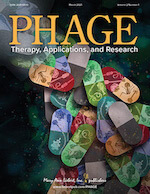What does it take to make phage therapy work in clinical practice in 2025? Who better to ask than the clinical lead at IPATH, the well-known phage therapy center run by UCSD in San Diego, which has set the example for phage therapy centers in so many states and countries since.
On this week’s episode of the Podovirus podcast, Joe and I were excited to sit down with Dr. Saima Aslam to understand how her approach has evolved since treating her first patient in 2017, and what her advice is for other phage clinicians.
The answer, it turns out, lies in a fundamental shift from “treating anything and everything” to strategic patient selection, as well as prioritizing close collaboration between phage researchers and clinicians. This way, trials can be designed that make sense for patients, clinicians and scientists.
One thing I really appreciated hearing was Saima’s assessment of where the field stands now: “I feel like this coming decade, where we have enough knowledge to design good trials, I personally think is going to either make it, or if we have multiple failed trials, that’s the end of it.”
I agree with this sentiment, and am excited to see what these next few years hold for phage therapy.
Highlights:
- Patient selection evolution: How Saima’s team moved from treating all-comers to targeted approaches, learning which infections respond best to phage therapy.
- The importance of collaboration: Why bringing together phage researchers and clinicians from the start leads to better clinical trial design with more realistic endpoints, so patients can be more easily recruited (they of course have lives to work around too!).
- Dosing insights: From treating phages like antibiotics every 8 hours, to understanding serum neutralization, biofilms, and the importance of local delivery for device infections, and adjusting dosing to fit that.
- Finding the sweet spot: Why recurrent UTIs in kidney transplant patients represent promising applications (even low hanging fruit, according to Saima) for proving phage efficacy.
- Infrastructure needs: The case for a centralized US phage repository and manufacturing center to eliminate the current 6-12 month delays that make compassionate use challenging for many cases.
A few snippets from the episode…
On the reality of complex cases:
“Even with the best phage, if we can’t change the underlying disease, I’m not sure treating the infection will help the patient get what they want.”
On the stakes for transplant patients:
“To have waited 10 years to get a kidney transplant and then you get recurrent UTIs and you lose it in two years is awful. It’s just terrible… If you don’t have recurrent UTIs, your kidney is good for the next 10 years.”
On trial design challenges:
“Some of the companies I’ve seen start trials have done so because they know the phage piece really well, but they haven’t really researched that clinical piece well. I think that’s a big reason why some of these studies have failed.”
On endpoints and timing:
“I think if we work collaboratively, if we can show it works in one thing, then we certainly will have a lot more money to figure out how it works in something else… We should pick sort of the lowest hanging fruit rather than the hardest ones to go after.”
On working across networks:
“I literally send out emails to whoever can help a patient… Texas A&M, Baylor College of Medicine, Daria Van Tyne’s lab in Pittsburgh, Graham Hatfull… It used to be mass emails, but now they’re more targeted because we know who really has phages that are ready to go.”
On the current phage-making bottleneck:
“Initially you would think ‘maybe this is a patient I would treat with phage’, and you would get phage a month later. Now there’s such a long backlog of cases that it takes more than six months, sometimes up to a year to get phage.”
What’s next:
Saima is leading an NIDDK-funded placebo-controlled trial for recurrent UTIs in kidney transplant patients. Her approach involves treating asymptomatic patients to target colonization rather than active infection, and the team just began enrolling this week!
Concluding thoughts
To me, this conversation crystallized why patient selection has become such a recurring theme across our phage therapy interviews. On one hand it’s driven by the need to ration a scarce resource, and not get patients’ hopes up unnecessarily, but it’s also about using phages only where we know they can succeed, so we can build solid evidence and insight quickly, and use that to design trials that are actually doable. By showing we can do this, we can bring in the funding and gain the experience to properly test the next set of indications, and expand out from there.
Thanks so much Saima for your time sharing these lessons!
Listen to the full episode:
🎧 Spotify
📺 YouTube
Learn more:







